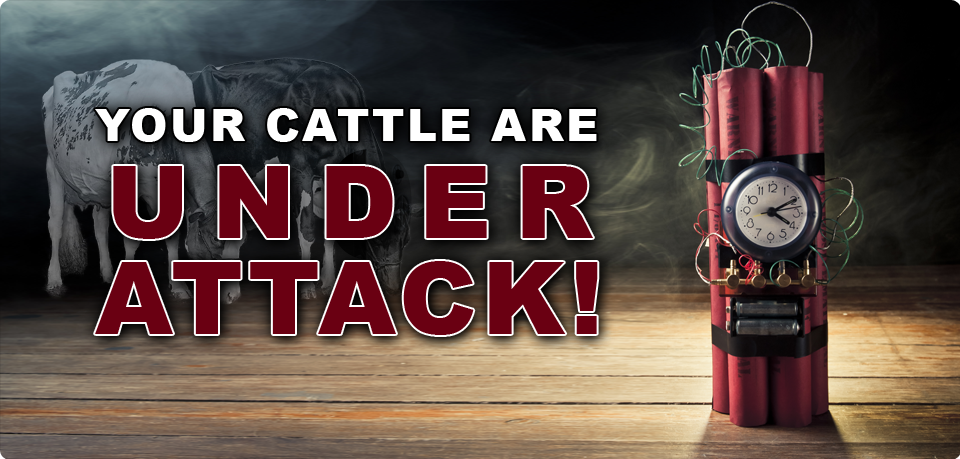In the fight against cattle diseases it feels like dairy breeders are constantly dodging shrapnel. Where will BSE or TB strike next? Have you been hit with mastitis, ketosis or metritis? Also, it is becoming harder and harder to fight back since there is a worldwide concerted effort to limit the use of antibiotics, particularly in food producing livestock. On top of that, animals are developing antibiotic resistance, making that course of action less and less effective.
After years of focusing on measurable traits – conformation, milk yield, protein yield – the dairy industry has started to take aim at health issues by recording somatic cell score evaluations. It is a small start in waging defense against disease. We must now take aim at an even bigger animal health picture, when looking at the future of our herds and our dairy industry.
You Already Have the Ultimate Weapon
The real fact is we already have the best disease defeating weapon at our disposal. It is the immune system of cattle. Animals with superior immune systems can do it all:
- Reduce disease
- Increase farm profit
- Improve milk quality
- Increase animal well being
DISEASE WARS – DNA Strikes Back!
Researchers at Ontario Veterinary College at Guelph University have identified that, when it comes to fighting disease, “One of the most attractive options available is to make use of the animal’s own immune response genes to select for healthier animals with naturally superior immunity.” The OVC group refers to these individuals as High Immune Responders. The really great news is that beyond the idea, the research and the studies is the fact that they have developed a patented test system to quickly identify these animals within dairy herds. This method is referred to as the High Immune Response (HIR) technology and they report that this approach can work well on both conventional and organic dairy farms.
HIR is FIGHTING BACK
The OVC group reports that there is clear evidence in cattle that it is possible to selectively breed for high (H), average (A) or low (L) – immune responsiveness and that H-responders can positively influence resistance to infectious disease. “In fact, early research by our group showed health and production benefits following genetic identification of cattle and pigs for enhanced IR. This included lower occurrence of mastitis in high immune responders in 2 out of 3 dairy herds tested, as well as improved response to vaccination and colostrum quality. “
We Have the Technology
The OVC group refers to these individuals with both higher and more optimally balanced antibody and cell-mediated immune responses, as High Immune Responders, and goes on to report that they have developed a patented test system to quickly identify these animals within dairy herds.
The HIR technology is designed to identify those cows and calves with robust and unbiased immune responsiveness that can be kept for future breeding to improve herd health, while low immune responders may be culled from the herd.
It is worth noting that, in general, a calf identified as a high responder will maintain that classification as a mature lactating cow. Therefore animals only need to be tested and classified based on their IR breeding value once in their lifetime.
Breeders Want HIR!
Qualitative market research using a cross section of focus groups was conducted by an independent firm, Agri-Studies (Guelph, Ontario). Results showed significant interest among dairy producers to use HIR to identify calves or cows with High Immune Response (75% of producers). The key benefit they saw was the ability to cull animals as calves and save the cost of raising animal that later may have significant health issues. They also saw the value of using sires that were classified as HIR to improve the health of their herds. Further market assessment and beta testing of dairy herds is now underway to finalize the transferability of the technology to the marketplace.
It’s All About Results
In 2010, 690 cows from 58 herds across Canada were immunized using the patented system to evaluate their IR profiles. In this study approximately 15% of cows were high, 15% were low, and 70% were average immune responders with some slight differences between provinces
- Health
Preliminary results show that among all cases of clinical mastitis in the cows across Canada that were tested for immune response, cows classified as HIR had the lowest occurrence of coagulase-negative staphylococci (CNS). - Production
Results to date have shown that breeding for optimal high immune response based on both antibody and cell-mediated immune responses would not compromise production. - Profit
In Canada, it costs the dairy producer $110 to $320 per case of mastitis, and it has been estimated that almost 1 out of every 5 dairy quarters in Canada is infected with a mastitis-causing pathogen
High Immune Response (HIR) Animals Are Naturally Immune
HIR is a patented evaluation technology developed to identify dairy cattle with high adaptive immune response capability. Identification is safe, fast and effective.
Benefits include:
- Lower disease occurrence and severity
- Reduced treatment and veterinary costs
- Increased response to vaccines
- Increased colostrum quality
- Cows as young as 2 months can be tested
- Animals only need to be tested once in a lifetime
- Testing is safe and does not interfere with any other diagnostic testing
- Cost benefit analysis show significant savings to producers who identify HIR cows in their herd.
The Future is Now!
Further market assessment and beta testing of dairy herds is now underway to finalize the transferability of the technology to the marketplace.
The Bullvine Bottom Line
No matter how scary the news makes the latest livestock health threat out to be, your herd’s natural immune defense system is the ultimate response.

















Leave a Reply
You must be logged in to post a comment.